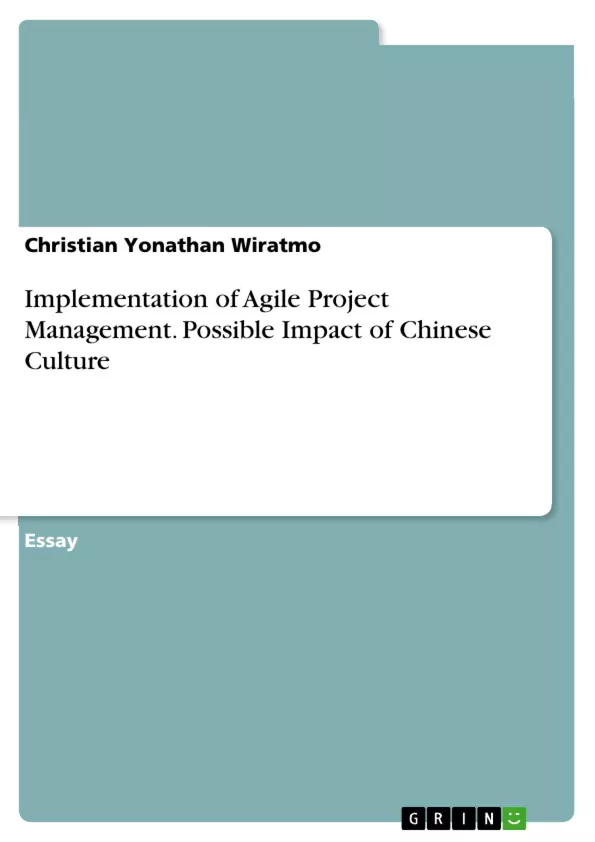This paper analyzes the different characteristics of Chinese culture and discusses its possible influence on the implementation of agile project management.
The Chinese belong to the high-context culture, which means that information is exchanged implicitly, for example by expressing criticism indirectly or by giving hints to express objection or difficulties instead of directly saying them clearly. They are highly dependent on leaders (expecting to be told what to do), like to work in groups, can be inconsistent in adhering to deals and agreements as well as avoid taking responsibility for decisions and avoid having any kind of conflict with others.
These traits can be beneficial for as well as pose challenges in the implementation of an agile project management, i.e. SCRUM. The group-based execution of SCRUM suits the Chinese as group-oriented people well. However, certain aspects in the implementation of SCRUM, such as setting and keeping goals (a.k.a. “Product Backlogs”), communicating difficulties with team leaders and SCRUM masters and giving constructive feedback during a Sprint review could be problematic for Chinese team members because of their aforementioned cultural traits.
Inhaltsverzeichnis (Table of Contents)
- Cultural Basic Orientation
- Power Distance
- Individualism
- Masculinity
- Uncertainty Avoidance
- Long-term vs. Short-term Orientation
- Indulgence vs. Restraint
- Typical communication and interaction patterns as well as dealing with conflicts
- Behavior in teams and the role of the managers/leaders
- Cultural requirements for the success of agile project work
Zielsetzung und Themenschwerpunkte (Objectives and Key Themes)
The paper explores the cultural characteristics of the Chinese people and their potential impact on the implementation of Agile Project Management, specifically focusing on the SCRUM methodology. The paper aims to identify how these cultural characteristics, as defined by Hofstede's cultural dimensions and other intercultural research, can influence the success of Agile projects in a Chinese context.
- Impact of Chinese cultural dimensions on Agile Project Management
- Influence of high-context communication and conflict avoidance on SCRUM implementation
- Role of leadership styles and team dynamics in a Chinese cultural context
- Specific challenges posed by Chinese cultural traits in Agile project execution
- Potential strategies for overcoming cultural barriers and maximizing Agile project success
Zusammenfassung der Kapitel (Chapter Summaries)
The first chapter provides a detailed overview of the cultural characteristics of Chinese people based on Hofstede's six cultural dimensions. This chapter examines the Chinese cultural traits relating to power distance, individualism, masculinity, uncertainty avoidance, long-term orientation, and indulgence versus restraint.
Chapter 2 delves into typical Chinese communication and interaction patterns, including their preference for high-context communication and indirect criticism. It also discusses the importance of "guanxi" - a system of reciprocal relationships and favors - in Chinese business culture. The chapter highlights the strong emphasis on conflict avoidance and the cultural preference for resolving issues privately and discreetly.
The third chapter examines the role of team dynamics and leadership in Chinese organizations. It explores the group-oriented nature of Chinese work culture and the importance of collective decision-making. The chapter also analyzes the impact of Confucianism on Chinese leadership expectations and how leaders are expected to provide guidance and direction.
Chapter 4 focuses on the specific cultural requirements for the success of Agile project work in a Chinese context. It examines how certain Chinese cultural traits, such as a preference for indirect communication and a high level of dependence on leadership, can pose challenges to the implementation of Agile methodologies like SCRUM. The chapter also explores strategies for mitigating these challenges and maximizing the benefits of Agile project management in China.
Schlüsselwörter (Keywords)
This paper explores key concepts such as Chinese cultural dimensions, high-context communication, guanxi, conflict avoidance, Agile Project Management, SCRUM methodology, cultural influence on project execution, team dynamics, leadership styles, and cross-cultural communication.
- Citar trabajo
- Christian Yonathan Wiratmo (Autor), 2022, Implementation of Agile Project Management. Possible Impact of Chinese Culture, Múnich, GRIN Verlag, https://www.grin.com/document/1355145



